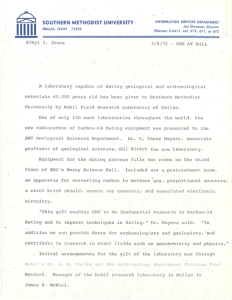The SMU radiocarbon laboratory operated within the Institute for the Study of Earth and Man (ISEM) between 1972 and 1993. Formally known as the Heroy Radiocarbon Laboratory, the lab was founded through gifts from the Mobil Field Research Laboratory and William B. Heroy. The laboratory was directed by C. Vance Haynes from 1972 until 1974, at which time Herbert Haas took over directorship.

SMU administration decided to close the laboratory in 1993, and the laboratory was transferred to the Desert Research Institute. A few years later, the laboratory was again transferred to the Center for Applied Isotope Studies at the University of Georgia.
During the more than two decades of operation at SMU, the laboratory generated over 2000 radiocarbon determinations for archaeological and geological research. Under the direction of Haas and Haynes, the SMU laboratory was instrumental in generating archaeological and geological dates for Paleoindian sites in the U.S. Southwest and Southern High Plains. Research at the lab established the first independent chronology of the Old and Middle Kingdoms in ancient Egypt. In the Northern Great Plains, the laboratory was a key source of dates for a large-scale project studying Native American Plains Village sites of the Middle Missouri River.
Many of the dates generated by the laboratory can be found in three published date lists in the journal Radiocarbon:
However, as is often the case, most of the 14C determinations made by the lab remain unpublished or available only within technical reports. The ARC maintains records and data produced by the laboratory. Between 2021 and 2022 funding from ISEM was used to digitize these records into a searchable database of radiocarbon dates.